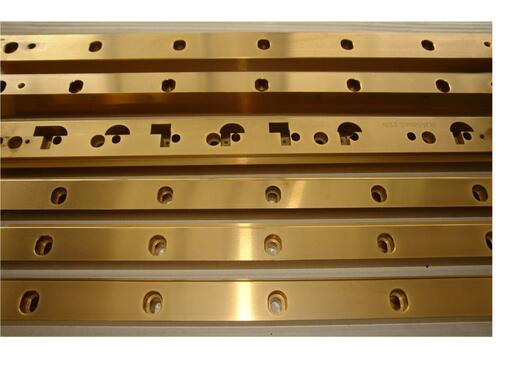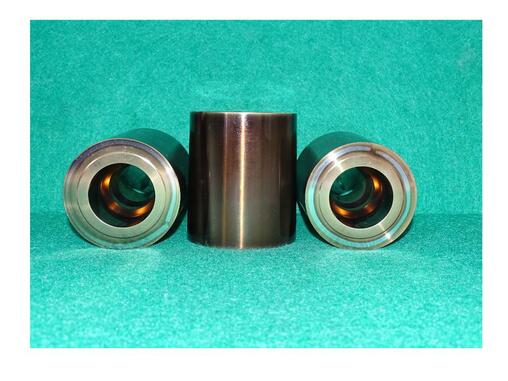![BBR Image 1a[3486] Microsection shows that the (CrMoVTi)C hard coating is firmly anchored to the substrate by the 3D TT-CVD process. © R&D Technical Center](https://bbr.news/wp-content/uploads/2022/02/BBR-Bild-1a3486-960x438.jpg)
Are PVD and CVD – at least their known variants – yesterday’s coating methods for tools? The future could belong to the 3D TT-CVD process.
In the mid-1950s, Metallgesellschaft developed a normal-pressure surface finishing process that made it possible for the first time to deposit hard materials such as TiC, TiN and TiCN with layer thicknesses of up to more than 10 µm on steel surfaces in the temperature range between 850 and 1,050 °C. This process was also used for the production of steel parts. The high microhardness of these hard materials of 2,450 HV (TiN) and 3,200 HV (TiCN), their low tendency to cold welding and their correspondingly low coefficient of friction made these materials particularly interesting for forming technology.

© R&D Technical Center
Problem: Warpage during hardening and tempering
Unfortunately, the high manufacturing temperature prevented widespread application of this process in the finishing of forming tools and cutting tools made of HSS. The reason for this is the repeated hardening and tempering of all coated tools required after coating. These thermal post-treatments almost always result in unrepairable warpage, which can affect 95 percent of all finished tools.
Nevertheless, they did not want to bury the technology immediately and decided to develop a particularly distortion-free steel. This was achieved in a particularly short time: The steel 1.2601 was produced in relatively large quantities. The development of this steel in conjunction with the normal-pressure chemical vapor deposition (CVD) process caused a considerable economic leap forward in forming technology. It was used to make various bending and punching tools. However, the normal pressure CVD process proved to be absolutely unsuitable for surface finishing of tools and machine components made of hard metal (HM). The cause is the formation of an undesirable, very brittle η-phase in the HM surface.
It was not until the mid-seventies that the η-phase problem was solved thanks to the development of the high-temperature CVD vacuum process. However, the vacuum process has not been able to solve the problem of renewed distortion-free thermal post-treatment (hardening and tempering three times) of tool steels. As a result, this process is still only suitable to a very limited extent, if at all, for the surface finishing of forming, machining and injection molding tools.
First solution: PVD
Three physical, reactive, low-temperature PVD coating processes were expected to provide the solution: the Balzers, the Multi-Arc and the Leybold-Heraeus processes. Thus, to date, metal nitrides, oxides, oxinitrides and sub-stoichiometric metal carbonitrides of the type MeC0.3N0.7 with a maximum microhardness of 2400 HV to 2500 HV between 100 °C and 700 °C can be produced without any problems. Pure stoichiometric carbides, mixed carbides with a microhardness of 2800 HV to 3200 HV and corresponding carbonitrides of MeC0.5N0.5 and MeC0.9N0.1 with a microhardness of 2,400 to 2,800 HV cannot be produced with these three methods.
Studies by Hans Krause (RWTH Aachen) in the 1970s and 1980s and further research by the Paterok brothers show that pure metal carbides and specifically manufactured mixed carbides are most effective against drilling friction, external friction, sliding friction, static friction, rolling friction and rolling friction. Their physical and chemical properties result in a serious reduction in abrasive and adhesive wear as well as tribo-oxidation, and to some extent also prevent surface disintegration.
Metal carbides were characterized in the tests by a particularly high abrasion resistance to ferrous metals, non-ferrous metals and non-ferrous alloys as well as a low coefficient of friction of 0.14 to 016, a microhardness of 3200 HV (TiN 2450 HV, Al2O3 2100 HV), a high melting point (TiC 3140 °C), a low thermal conductivity, a low thermal expansion and – especially TiC – a very good adhesion to both steel and hard metals.

© R&D Technical Center
Better solution: 3D TT-CVD
Because of these properties, already at the beginning of the 1980s, ways and means were sought for the production of metal carbides, which could be deposited on their surfaces in the annealing temperature range of forming and injection molding tools with complicated and a very precise geometric shape. In the last decade, Paterok brothers achieved production readiness for a new 3D low-temperature CVD process (3D-TT-CVD) at the Technical R&D Center for Surface Refinement and High-Performance Toolmaking in Schömberg in the northern Black Forest. The deposition of metal carbides instead of PVD nitrides on both geometrically simple and very complicated and deep forming and injection molding tools resulted in a considerable increase in service life.
This process is used to coat tools and various machine components with both very shallow and very deep 3D surface structures, such as wire drawing dies made of steel and carbide, deep-drawing rings and punches, single-groove dies and punches, threaded dies, thread rolls for flat die and segment processes, dies for grooving, combined grooving-axial pushing, extrusion bushes, intermediate plates, press punches, dies and punches for free bending, V-, U-bending, rolls for roll bending, in the temperature range 520 °C to 550 °C with corresponding mixed carbides.
Forming tools are manufactured in the industry from cold work, hot work, high speed steels (HSS) and different hard metals. Depending on the steel grade, the tempering temperature is between 150 °C and 560 °C. In order to achieve very good tool life by coating, the tool material for dies, jaws, bushings, deep-drawing rings, rollers (rolls) and punches should be selected so that the tempering temperature is above 540 °C, i.e. preferably hot work, HSS or carbide.
Among other things, bending strips made of the steel 1.2379 are refined in Schömberg with the nano-hard material system (CrMoVTi)C by 3D-TT-CVD. Here, the tool life for U-bending sheet metal has increased four to six times compared with TiCN (PVD)-coated bending bars. When roll bending 2.5 millimeter thick V4a sheet (1.4571), the service life of solid carbide bending rolls was increased eight to nine times. By using (CrMoTi)C, the service life of some dies and corresponding U-bending bars with a total length of 950 millimeters could be increased by 450 to 700 percent compared to PVD with TiN.
Huge increases in service life
HSS dies and punches coated by 3D-TT-CVD for copper deep drawing (99.7% Cu) endured 250,000 instead of 35,000. Previously, the wear driver was the cold welding of the tool surface to the copper. Something similar had been experienced with 99.5 percent silver (6 to 7 times service life). Some other Fe and NE alloys had “only” produced an increase to four times. The low tendency to cold welding was always observed.
The prerequisite for good results is the quality of the tool material: Rusty surfaces, defective edges and corners, erosion defects, ballast and chatter marks cannot be healed by the best coating, and internal structural changes, often more than 20 µm in depth, can no longer be eliminated. Such surface defects on the tool body are usually the cause of poor adhesion of even the best coating.
